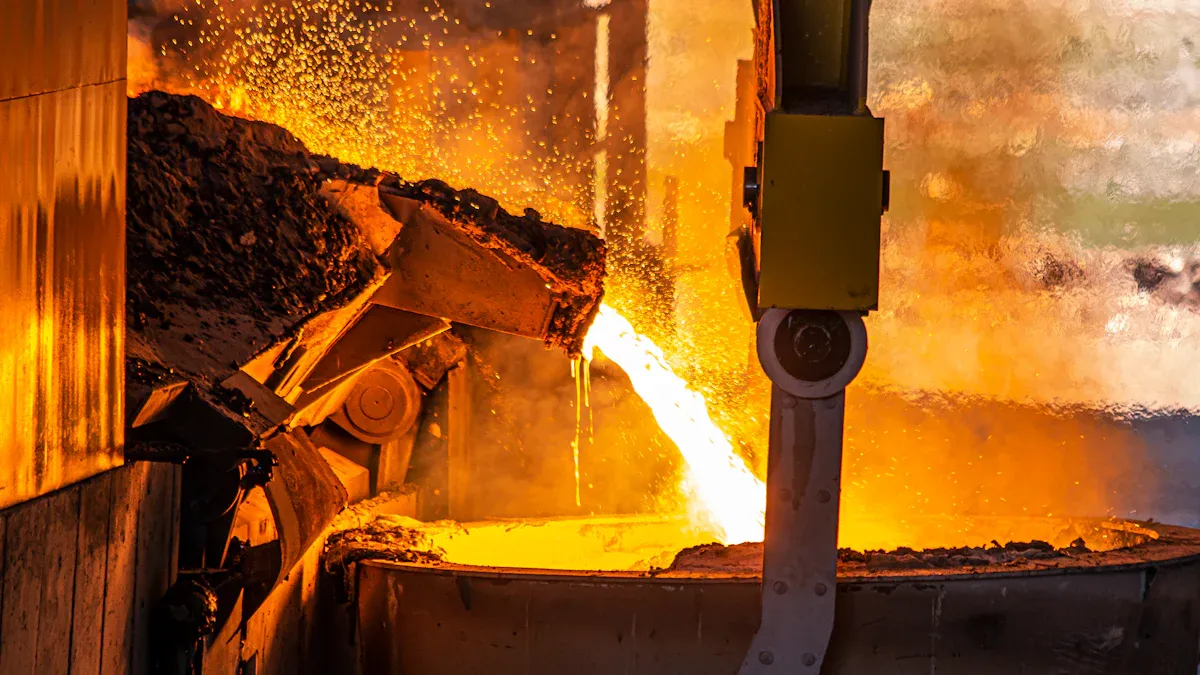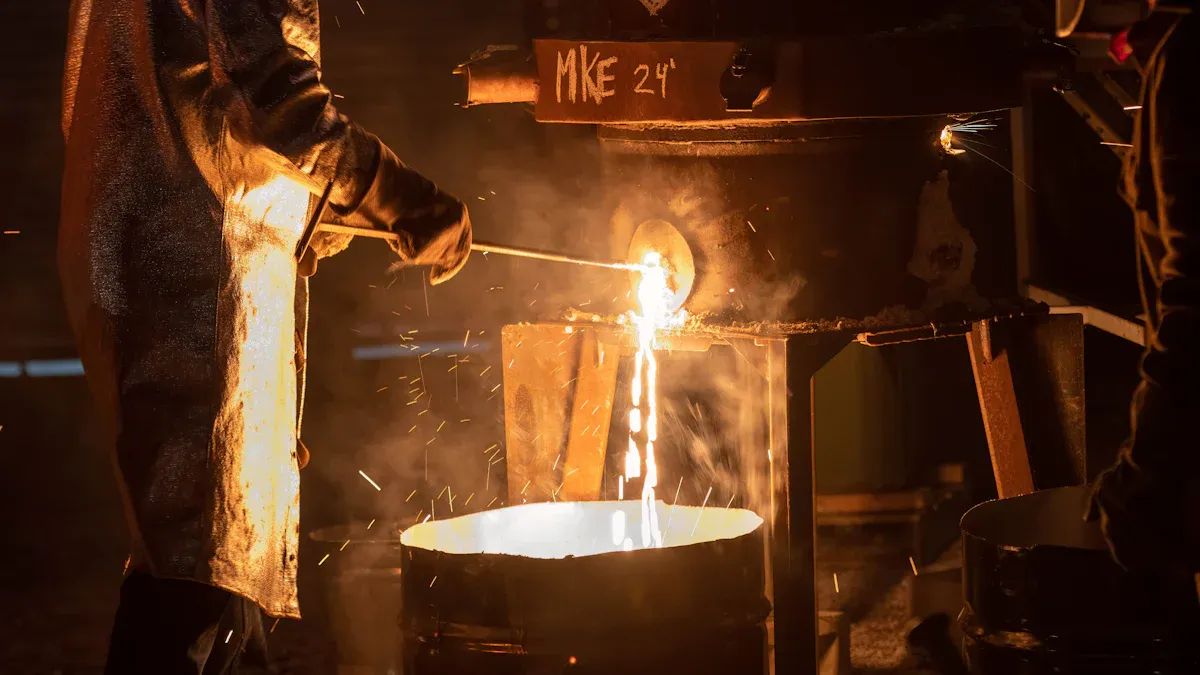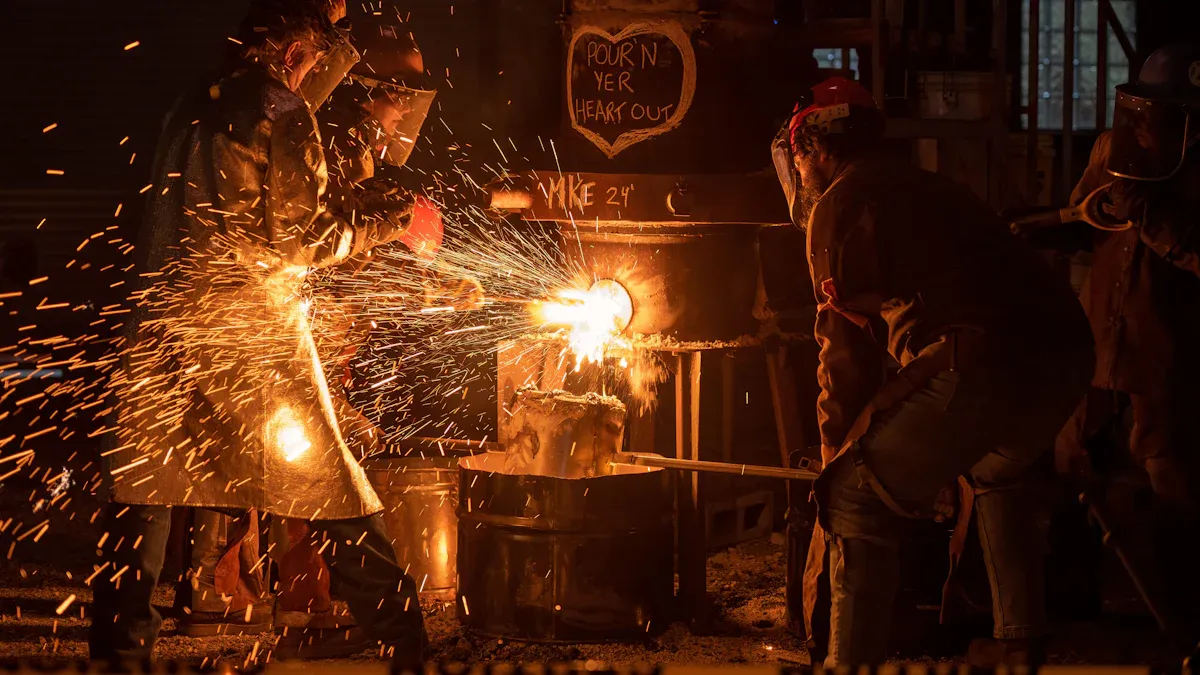Why Aluminum Alloy Die Casting Is the Future of Manufacturing in 2025

Aluminium alloy die casting is revolutionizing how you think about manufacturing. This method creates parts that are strong yet lightweight, making it perfect for industries like automotive and aerospace. Its sustainable nature also appeals to businesses focused on reducing environmental impact. You’ll see aluminium alloy die casting as a preferred choice because it combines cost-effectiveness with durability. Aluminium die casting manufacturers rely on this process to produce precise components while minimizing waste. As technology advances, aluminium die casting suppliers are adopting smarter techniques to refine the aluminium die casting process even further.
Key Takeaways
- Aluminum alloy die casting makes strong and light parts. It is great for cars and planes.
- This method saves money and cuts waste. It uses molds again and wastes less material.
- Aluminum alloys don’t rust and handle tough conditions. They last long in many uses.
- The process makes detailed designs and exact parts. It saves time and materials with close-to-final shapes.
- Using aluminum alloy die casting helps the planet. It supports recycling and uses less energy.
Understanding Aluminum Alloy Die Casting
What Is Aluminum Alloy Die Casting
Aluminum alloy die casting is a manufacturing process that creates precise and complex metal parts. It involves injecting molten aluminum alloy into a steel mold, called a die, under high pressure. This process allows you to produce components with excellent accuracy and a smooth surface finish. The molds are reusable, making the process efficient for high-volume production. You’ll find that aluminum alloy die casting is widely used because it delivers consistent results and reduces material waste.
Why Aluminum Alloys Are Ideal for Die Casting
Aluminum alloys are perfect for die casting due to their unique properties. These alloys are lightweight yet strong, making them ideal for industries like automotive and aerospace. They also resist corrosion, ensuring durability in harsh environments. Aluminum alloys have excellent thermal and electrical conductivity, which enhances their performance in various applications. Additionally, their ability to flow easily when molten allows you to create intricate designs with minimal effort. These qualities make aluminum alloy die casting a preferred choice for manufacturers.
Common Applications in Manufacturing Industries
You’ll see aluminum alloy die casting used in many industries. In the automotive sector, it helps produce engine components, transmission cases, and wheels. The aerospace industry relies on it for lightweight parts like brackets and housings. Electronics manufacturers use it to create heat sinks and enclosures for devices. Even the construction industry benefits from aluminum alloy die casting, using it for durable and lightweight structural components. Its versatility ensures its relevance across diverse fields.
Key Benefits of Aluminum Alloy Die Casting

Cost-Efficiency and Waste Reduction
You’ll find aluminum alloy die casting to be one of the most cost-effective manufacturing methods available. The process allows you to produce large quantities of components with minimal material waste. Unlike traditional casting methods, this technique uses reusable steel molds, which reduces the need for constant mold replacement. This efficiency lowers production costs significantly.
Additionally, the precision of aluminum alloy die casting minimizes the need for secondary machining. You can achieve near-net-shape parts directly from the mold, saving both time and resources. The process also optimizes material usage by recycling excess aluminum alloy, further reducing waste. This makes it an environmentally friendly option for manufacturers aiming to cut costs while maintaining sustainability.
Lightweight Properties and Strength-to-Weight Ratio
Aluminum alloy die casting offers an exceptional balance between weight and strength. Components made through this process are lightweight yet durable, making them ideal for industries like automotive and aerospace. You’ll notice that lighter parts contribute to improved fuel efficiency in vehicles and aircraft, which is a critical factor in reducing operational costs and environmental impact.
The high strength-to-weight ratio of aluminum alloys ensures that the parts can withstand significant stress without adding unnecessary bulk. This property is particularly valuable in applications where weight reduction is essential without compromising structural integrity. By choosing aluminum alloy die casting, you can create components that are both efficient and reliable.
Durability and Resistance to Harsh Environments
When you need parts that can endure tough conditions, aluminum alloy die casting delivers. Aluminum alloys are naturally resistant to corrosion, which makes them suitable for use in environments exposed to moisture, chemicals, or extreme temperatures. This resistance ensures that the components maintain their performance and appearance over time.
The durability of aluminum alloy die casting extends to its ability to withstand mechanical stress. Parts produced through this method are less prone to wear and tear, even under heavy usage. This longevity reduces the need for frequent replacements, saving you money and ensuring consistent performance in demanding applications. Whether in automotive engines or outdoor construction, aluminum alloy die casting provides the durability you need.
Design Flexibility for Complex and Precise Components
Aluminum alloy die casting gives you unmatched design flexibility, making it ideal for creating intricate and precise components. The process allows you to produce parts with complex geometries that would be difficult or impossible to achieve using other manufacturing methods. Whether you need thin walls, sharp edges, or detailed textures, this technique delivers exceptional results.
One of the key advantages is the ability to create near-net-shape components. This means the parts come out of the mold with minimal need for additional machining or finishing. You save time and resources while achieving high levels of accuracy. For example, if you’re designing a component with internal cavities or intricate patterns, aluminum alloy die casting ensures these features are formed seamlessly in a single step.
Tip: When designing parts for aluminum alloy die casting, consider incorporating features like ribs or gussets. These can enhance the strength of your components without adding extra weight.
The process also supports a wide range of surface finishes. You can achieve smooth, polished surfaces or textured finishes, depending on your application. This versatility makes it suitable for industries like automotive, aerospace, and consumer electronics, where both functionality and aesthetics matter.
Additionally, aluminum alloy die casting works well for producing components with tight tolerances. If your project requires precise dimensions, this method ensures consistency across high-volume production runs. You can rely on it to maintain uniformity, even for the most demanding applications.
Comparing Aluminum Alloy Die Casting to Other Methods
Advantages Over Traditional Casting Techniques
You’ll find aluminum alloy die casting offers several advantages over traditional casting methods. Traditional techniques, like sand casting, often require more time and effort to produce parts. The molds used in sand casting are single-use, which increases production costs and waste. In contrast, aluminum alloy die casting uses reusable steel molds. This makes the process faster and more cost-effective for high-volume production.
Another key advantage is precision. Traditional casting methods may struggle to achieve tight tolerances or smooth surface finishes. Aluminum alloy die casting, however, delivers parts with exceptional accuracy and minimal need for post-processing. You can create intricate designs and complex geometries that would be difficult to achieve with older methods.
Note: If you’re looking for a method that combines efficiency with precision, aluminum alloy die casting is a superior choice compared to traditional casting techniques.
Comparison with Machining and Other Manufacturing Processes
When you compare aluminum alloy die casting to machining, the differences become clear. Machining involves cutting material from a solid block to create a part. While this method can produce precise components, it generates significant material waste. Aluminum alloy die casting, on the other hand, minimizes waste by using molten metal to form parts directly.
Machining also tends to be slower and more expensive for large production runs. Each part requires individual attention, which increases labor and time costs. Aluminum alloy die casting excels in high-volume production. The process allows you to produce thousands of identical parts quickly and efficiently.
Other manufacturing methods, like 3D printing, may offer design flexibility but lack the speed and cost-efficiency of die casting. Aluminum alloy die casting strikes the perfect balance between precision, speed, and affordability. It’s an ideal choice for industries that demand both quality and efficiency.
Why It’s Ideal for High-Volume and Precision Production
Aluminum alloy die casting stands out as the best option for high-volume and precision production. The process uses automated machinery to inject molten metal into molds, ensuring consistent results across large batches. You can produce thousands of parts with identical dimensions and features, which is crucial for industries like automotive and aerospace.
The precision of aluminum alloy die casting eliminates the need for extensive post-production work. Parts come out of the mold with near-net-shape accuracy, saving you time and resources. This makes the process highly efficient for meeting tight deadlines and large-scale demands.
Additionally, the durability of the molds ensures they can be reused for multiple production cycles. This reduces costs and makes the process more sustainable. If your project requires high-quality components in large quantities, aluminum alloy die casting offers the perfect solution.
The Future of Manufacturing with Aluminum Alloy Die Casting

Sustainability and Recycling Benefits
Aluminum alloy die casting supports sustainability by reducing waste and promoting recycling. You can reuse excess aluminum alloy from the casting process, minimizing material loss. This makes it an eco-friendly option for manufacturers aiming to lower their environmental impact. Aluminum alloys are also fully recyclable, allowing you to repurpose old components into new products without compromising quality.
The lightweight nature of aluminum alloy die casting contributes to energy efficiency. Lighter parts reduce fuel consumption in vehicles and aircraft, helping industries meet stricter emissions standards. By choosing this method, you align your manufacturing practices with global sustainability goals.
Tip: If you want to enhance your company’s green initiatives, consider adopting aluminum alloy die casting for its recycling benefits and energy-saving properties.
Integration with Advanced Technologies (e.g., Automation, AI)
Aluminum alloy die casting integrates seamlessly with advanced technologies like automation and artificial intelligence (AI). Automated machinery streamlines the casting process, ensuring consistent quality and faster production times. You can use AI to monitor and optimize operations, reducing errors and improving efficiency.
Smart sensors and data analytics enhance precision during the casting process. These tools allow you to detect defects early and make adjustments in real time. By leveraging automation and AI, you can scale production while maintaining high standards.
Note: Investing in advanced technologies for aluminum alloy die casting not only boosts productivity but also positions your business as a leader in innovation.
Alignment with Industry 4.0 and Smart Manufacturing Trends
Aluminum alloy die casting aligns perfectly with Industry 4.0 and smart manufacturing trends. You can integrate this process into connected systems that use IoT devices to monitor and control production. This connectivity enables you to track performance metrics and optimize workflows remotely.
The adaptability of aluminum alloy die casting makes it ideal for smart factories. You can customize molds and processes to meet specific requirements, ensuring flexibility in production. This approach supports mass customization, a key feature of Industry 4.0.
Emoji Insight: Embracing aluminum alloy die casting in smart manufacturing helps you stay competitive in a rapidly evolving industrial landscape.
Aluminum alloy die casting offers unmatched benefits for modern manufacturing. You gain cost-efficiency, durability, and adaptability, making it an essential process for industries. Its sustainable nature aligns with global environmental goals, while its compatibility with advanced technologies ensures relevance in the future. By adopting aluminum alloy die casting, you position your business to thrive in an evolving industrial landscape. This method will remain a cornerstone for creating efficient and sustainable solutions as industries continue to innovate.
FAQ
What makes aluminum alloy die casting better than other manufacturing methods?
Aluminum alloy die casting offers precision, speed, and cost-efficiency. You can produce complex parts with tight tolerances and smooth finishes. Unlike machining, it minimizes material waste. Its lightweight and durable properties make it ideal for industries like automotive, aerospace, and electronics.
Tip: Choose aluminum alloy die casting for high-volume production with consistent quality.
Can aluminum alloy die casting support sustainable manufacturing?
Yes, aluminum alloy die casting promotes sustainability. You can recycle excess material and repurpose old components without losing quality. Its lightweight nature reduces energy consumption in transportation. This process aligns with global environmental goals and helps you reduce your carbon footprint.
Eco-Friendly Insight: Aluminum alloys are 100% recyclable.
Is aluminum alloy die casting suitable for small-scale production?
While aluminum alloy die casting excels in high-volume production, it can also work for small-scale projects. You can reuse molds for multiple cycles, reducing costs. However, initial setup expenses may be higher for smaller runs. Evaluate your production needs to determine if it’s the right fit.
How does automation improve aluminum alloy die casting?
Automation enhances efficiency and precision. You can use automated machinery to streamline the casting process and ensure consistent results. AI tools help monitor operations and detect defects early. This technology reduces errors, speeds up production, and lowers costs.
Note: Automation positions your business as a leader in innovation.
What industries benefit most from aluminum alloy die casting?
Automotive, aerospace, electronics, and construction industries benefit the most. You can create lightweight engine parts, durable brackets, heat sinks, and structural components. Its versatility ensures relevance across diverse applications.
Industry Insight: Aluminum alloy die casting improves fuel efficiency in vehicles and aircraft.